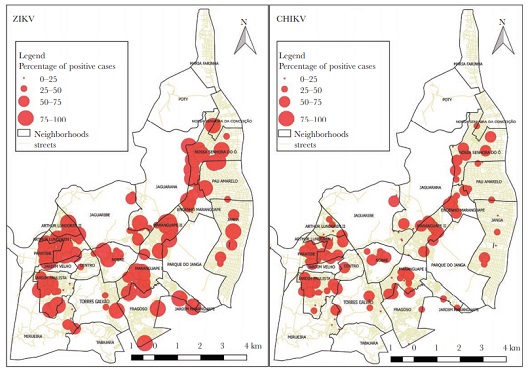Research confirms sexual transmission of zika virus in Pernambuco State
26/10/2020
Fiocruz Pernambuco
Research by Fiocruz Pernambuco, in collaboration with the Colorado State University (CSU), USA, has found scientific evidence of the importance of sexual transmission of the virus in the zika epidemic in Pernambuco. This is the first Brazilian study to reach this conclusion, and the second worldwide to show that sexual transmission of the zika virus played a much more significant role in the epidemic than what was initially thought. The first study took place in Porto Rico, in 2019.
Other previous studies had already proven the existence of this form of transmission in places where the vector mosquito, Aedes aegypti, was not present, but had not stated its relevance in the epidemic. The Pernambuco study shows that this contribution is significant. “Sexual transmission does not seem to be the sole responsible for the sustained contagion of the zika virus, but, associated to the transmission via mosquito, it can contribute significantly to the efficient dissemination of the virus”, explains researcher Tereza Magalhães (CSU and Fiocruz PE), who coordinated the project together with researchers Ernesto Marques (Fiocruz PE and the University of Pittsburgh, USA) and Brian Foy (CSU). The research was funded by the National Institutes of Health (NIH).
In addition to the methodological attention required to identify sexual transmission separately from the vector transmission, the team had to overcome a huge challenge early in the research: the drastic reduction in cases of zika after 2017, in the state of Pernambuco and all over the country, which made it impossible to identify new cases to add to the cohort of the study. Investigators were therefore forced to search for an alternative strategy for the project, involving participants of a previous study on the diagnostic of dengue fever, and inhabitants of their homes. Carried out by Tereza and Ernesto between May 2015 and May 2016, this study recruited patients cared for at the Health Unit of Paulista, Pernambuco, with symptoms that suggested dengue fever. The work was a collaboration with Thomas Jaenisch, researcher of the University of Heidelberg (Germany) and of the CSU.
The result was surprising: after all the analysis, 60% of the more than two hundred and fifty patients under study were confirmed cases of infection by zika and chikungunya viruses, with very few cases of dengue fever. This study has therefore proven to be an important record of the final stage of the zika epidemic and of the later rise in the number of cases of chikungunya in Pernambuco; both diseases had spread silently among the population.
Based on this accumulated knowledge, the participants of this previous research (now called index) were invited, together with their sex partners and up to two people who live in the same household, forming a cohort of 425 people. The goal was to use serological tests to compare previous exposure of participants to the zika and chikungunya viruses. The hypothesis was that exposure to the zika virus would be higher among sex partners, as this virus is transmitted sexually and through mosquito bites. The comparison with chikungunya was very important for the study, as it is not transmitted sexually (only via mosquito bite).
Blood samples were collected, serological tests were made, and questionnaires were applied, to respond to two types of analysis. The study first evaluated the risk of subjects testing positive for zika or chikungunya when living with an index patient positive for the respective virus, whether they were sex partners or not. This same risk was then observed in all pairs of the same household, regardless of the presence or not of an index patient in the pairs.
The results showed that, in the case of zika, the risk of having been exposed to the virus was significantly higher (relative risk: 3.9) for the sex partner than for other people living in the same household, but who were not their sex partners (relative risk: 1.2). For the chikungunya virus, used as control in this research, the result was very different, and the risk was the same for all those living in the household (sex partners or not; relative risk: 2-2.5). In the second part of the analysis, the sex pairs in the households showed a higher probability of having a concordant serology for zika virus than pairs without sexual relations, a fact that was not observed with the chikungunya group.

Retrospective clinical data of the participants were also collected. One piece of information obtained for the participants who tested positive for the zika virus was that a lower percentage of sexual pairs stated having symptoms typical of arboviruses diseases when compared with non-sexual pairs. “This may indicate that if these people were infected by zika via sexual relationships and not mosquito bites, perhaps symptoms are different according to the kind of transmission”, declares Tereza, highlighting the importance of taking this factor into account during the acute phase of the disease. “This is relevant for the clinical approach as well, as a physician may not be able to make a correct diagnosis if only typical symptoms are evaluated”, she added.
The study showed that sexual transmission of the zika virus in endemic areas, associated with mosquito bite transmission, may have been one of the factors responsible for the rapid dissemination of the virus in the Americas and in other regions affected by the 2015/2016 pandemic.
More details on the research, which also included the participation of Ana Brito, Clarice Morais and Marli Tenório, researchers of Fiocruz Pernambuco, in addition, fo that of many students and technicians of the institution, can be found in the article Follow-up household serosurvey in Northeast Brazil for Zika virus: sexual contacts of index patients have the highest risk for seropositivity.




